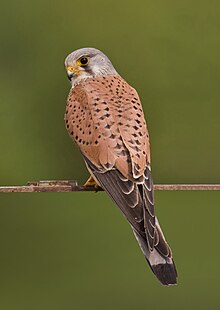Australaves: Difference between revisions
Ornithodiez (talk | contribs) No edit summary |
m linking to the article for clade. that's not a word most people know. |
||
| Line 10: | Line 10: | ||
*[[Eufalconimorphae]] |
*[[Eufalconimorphae]] |
||
}} |
}} |
||
'''Australaves'''<ref>{{cite journal |vauthors=Kimball RT, Wang N, Heimer-McGinn V, Ferguson C, Braun EL |year=2013 |title=Identifying localized biases in large datasets: A case study using the Avian Tree of Life. |publisher=Mol Phylogenet Evol |doi=10.1016/j.ympev.2013.05.029 |volume=69 |journal=Molecular Phylogenetics and Evolution |pages=1021–1032 |pmid=23791948}}</ref> is a recently defined<ref name=ericson2012>{{cite journal | last1 = Ericson | first1 = P. G. | year = 2012 | title = Evolution of terrestrial birds in three continents: biogeography and parallel radiations | url = http://www.naturhistoriska.com/download/18.9ff3752132fdaeccb6800037316/1335164422875/Ericson+Gondwana+JBI+2012.pdf | format = PDF | journal = Journal of Biogeography | volume = 39 | issue = 5| pages = 813–824 | doi=10.1111/j.1365-2699.2011.02650.x}}</ref> clade of [[bird]]s, consisting of the [[Eufalconimorphae]] ([[passerine]]s, [[parrot]]s and [[falcon]]s) as well as the [[Cariamiformes]] (including [[seriama]]s and the extinct "[[terror bird]]s").<ref name=naish2012>Naish, D. (2012). "Birds." Pp. 379-423 in Brett-Surman, M.K., Holtz, T.R., and Farlow, J. O. (eds.), ''The Complete Dinosaur (Second Edition)''. Indiana University Press (Bloomington & Indianapolis).</ref> They appear to be the sister group of [[Afroaves]].<ref name=naish2012 /> As in the case of Afroaves, the most [[Basal (phylogenetics)|basal]] clades have predatory extant members, suggesting this was the ancestral lifestyle;<ref name = "Jarvis2014"/> however, some researchers like [[Darren Naish]] are skeptical of this assessment, since some extinct representatives such as the herbivorous ''[[Strigogyps]]'' lead other lifestyles.<ref>[http://blogs.scientificamerican.com/tetrapod-zoology/bird-behaviour-the-e28098deep-timee28099-perspective/ Bird behaviour, the ‘deep time’ perspective]</ref> Basal parrots and falcons are at any rate vaguely [[crow]]-like and probably omnivorous.<ref>L. D. Martin. 2010. Paleogene avifauna of the holarctic. Vertebrata PalAsiatica 48:367-374</ref> |
'''Australaves'''<ref>{{cite journal |vauthors=Kimball RT, Wang N, Heimer-McGinn V, Ferguson C, Braun EL |year=2013 |title=Identifying localized biases in large datasets: A case study using the Avian Tree of Life. |publisher=Mol Phylogenet Evol |doi=10.1016/j.ympev.2013.05.029 |volume=69 |journal=Molecular Phylogenetics and Evolution |pages=1021–1032 |pmid=23791948}}</ref> is a recently defined<ref name=ericson2012>{{cite journal | last1 = Ericson | first1 = P. G. | year = 2012 | title = Evolution of terrestrial birds in three continents: biogeography and parallel radiations | url = http://www.naturhistoriska.com/download/18.9ff3752132fdaeccb6800037316/1335164422875/Ericson+Gondwana+JBI+2012.pdf | format = PDF | journal = Journal of Biogeography | volume = 39 | issue = 5| pages = 813–824 | doi=10.1111/j.1365-2699.2011.02650.x}}</ref> [[clade]] of [[bird]]s, consisting of the [[Eufalconimorphae]] ([[passerine]]s, [[parrot]]s and [[falcon]]s) as well as the [[Cariamiformes]] (including [[seriama]]s and the extinct "[[terror bird]]s").<ref name=naish2012>Naish, D. (2012). "Birds." Pp. 379-423 in Brett-Surman, M.K., Holtz, T.R., and Farlow, J. O. (eds.), ''The Complete Dinosaur (Second Edition)''. Indiana University Press (Bloomington & Indianapolis).</ref> They appear to be the sister group of [[Afroaves]].<ref name=naish2012 /> As in the case of Afroaves, the most [[Basal (phylogenetics)|basal]] clades have predatory extant members, suggesting this was the ancestral lifestyle;<ref name = "Jarvis2014"/> however, some researchers like [[Darren Naish]] are skeptical of this assessment, since some extinct representatives such as the herbivorous ''[[Strigogyps]]'' lead other lifestyles.<ref>[http://blogs.scientificamerican.com/tetrapod-zoology/bird-behaviour-the-e28098deep-timee28099-perspective/ Bird behaviour, the ‘deep time’ perspective]</ref> Basal parrots and falcons are at any rate vaguely [[crow]]-like and probably omnivorous.<ref>L. D. Martin. 2010. Paleogene avifauna of the holarctic. Vertebrata PalAsiatica 48:367-374</ref> |
||
{{clade|style=font-size:90%;line-height:100% |
{{clade|style=font-size:90%;line-height:100% |
||
Revision as of 18:10, 5 April 2017
| Australavians | |
|---|---|

| |
| Kestrel, Falco tinnunculus | |
| Scientific classification | |
| Domain: | Eukaryota |
| Kingdom: | Animalia |
| Phylum: | Chordata |
| Class: | Aves |
| Clade: | Telluraves |
| Clade: | Australaves Ericson, 2012 |
| Clades | |
Australaves[1] is a recently defined[2] clade of birds, consisting of the Eufalconimorphae (passerines, parrots and falcons) as well as the Cariamiformes (including seriamas and the extinct "terror birds").[3] They appear to be the sister group of Afroaves.[3] As in the case of Afroaves, the most basal clades have predatory extant members, suggesting this was the ancestral lifestyle;[4] however, some researchers like Darren Naish are skeptical of this assessment, since some extinct representatives such as the herbivorous Strigogyps lead other lifestyles.[5] Basal parrots and falcons are at any rate vaguely crow-like and probably omnivorous.[6]
| Australaves |
| ||||||||||||||||||
Cladogram of Australaves relationships based on Jarvis, E.D. et al. (2014).[4]
References
- ^ Kimball RT, Wang N, Heimer-McGinn V, Ferguson C, Braun EL (2013). "Identifying localized biases in large datasets: A case study using the Avian Tree of Life". Molecular Phylogenetics and Evolution. 69. Mol Phylogenet Evol: 1021–1032. doi:10.1016/j.ympev.2013.05.029. PMID 23791948.
- ^ Ericson, P. G. (2012). "Evolution of terrestrial birds in three continents: biogeography and parallel radiations" (PDF). Journal of Biogeography. 39 (5): 813–824. doi:10.1111/j.1365-2699.2011.02650.x.
- ^ a b Naish, D. (2012). "Birds." Pp. 379-423 in Brett-Surman, M.K., Holtz, T.R., and Farlow, J. O. (eds.), The Complete Dinosaur (Second Edition). Indiana University Press (Bloomington & Indianapolis).
- ^ a b Jarvis, E. D.; Mirarab, S.; Aberer, A. J.; Li, B.; Houde, P.; Li, C.; Ho, S. Y. W.; Faircloth, B. C.; Nabholz, B.; Howard, J. T.; Suh, A.; Weber, C. C.; Da Fonseca, R. R.; Li, J.; Zhang, F.; Li, H.; Zhou, L.; Narula, N.; Liu, L.; Ganapathy, G.; Boussau, B.; Bayzid, M. S.; Zavidovych, V.; Subramanian, S.; Gabaldon, T.; Capella-Gutierrez, S.; Huerta-Cepas, J.; Rekepalli, B.; Munch, K.; et al. (2014). "Whole-genome analyses resolve early branches in the tree of life of modern birds" (PDF). Science. 346 (6215): 1320–1331. doi:10.1126/science.1253451. PMC 4405904. PMID 25504713.
- ^ Bird behaviour, the ‘deep time’ perspective
- ^ L. D. Martin. 2010. Paleogene avifauna of the holarctic. Vertebrata PalAsiatica 48:367-374

